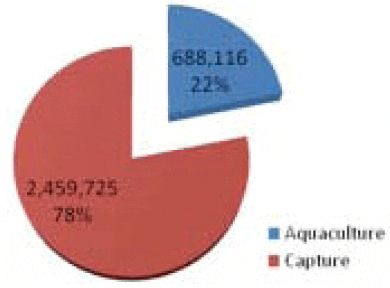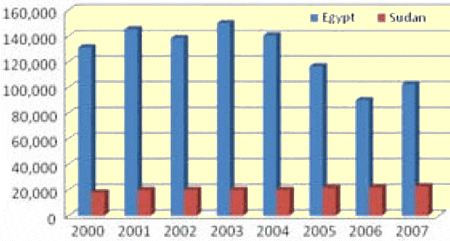Collectively the Arab region consists of twenty-two Arab states with more than 23,000 km of shoreline and 707,000 sq km of continental shelf area. It has access to two oceans, three major seas, several gulfs, lagoons and a large expanse into the Economic Exclusive Zones (EEZ). They also have within their borders fresh and brackish natural and man-made lakes, rivers and several tributaries. In spite of this environment, fisheries production does not satisfy the demands for fish and fishery products.
In recent years, several Arab states resorted to aquaculture to increase local fish supplies. While some states made significant progress in this endeavor especially Egypt and Saudi Arabia, overall the Arab states are net importers of fish and fishery products. The 2007 average annual per capita fish consumption as estimated by the Food and Agriculture Organisation of the United Nations (FAO) was less than 10 kg versus the international average of 16.7 kg. In order to increase the average per capita consumption and to reduce imports, opportunities to boost local production is vested in expanding aquaculture projects in marine and inland waters.
Fish production
The latest FAO fisheries statistics for 2007 indicated that the Arab states produced a total of 3.1 million tonnes of fish by capture fisheries and aquaculture. Of this quantity 2.5 million tonnes (79.1 per cent of total production) were from marine and fresh water capture fisheries and 688,000 tonnes (21.9 per cent) from aquaculture. The major fish producers are Egypt with one million tonnes, Morocco with 894,000 tonnes and Mauritania being a distant third with 202,000 tonnes. The small producers were Djibouti with only 265 tonnes, Jordan with 1,015 tonnes and Palestine with 2,702 tonnes (Table 1).
|
Table 1. Aquaculture and capture fish production in 2007 (tonnes).
|
|||
| Arab states | Aquaculture | Capture | Total |
|---|---|---|---|
| Algeria | 405 | 148,437 | 148,842 |
| Bahrain | 1 | 15,013 | 15,013 |
| Comoros | - | 16,000 | 16,000 |
| Djibouti | - | 265 | 265 |
| Egypt | 635,516 | 372,492 | 1,008,008 |
| Iraq | 15,810 | 57,779 | 73,589 |
| Jordan | 509 | 506 | 1,015 |
| Kuwait | 348 | 4,373 | 4,721 |
| Lebanon | 803 | 3,811 | 4,614 |
| Libya | 240 | 31,924 | 32,164 |
| Mauritania | - | 201,588 | 201,588 |
| Morocco | 1,636 | 892,820 | 894,456 |
| Oman | 90 | 151,744 | 151,834 |
| Palestine | - | 2,702 | 2,702 |
| Qatar | 36 | 15,190 | 15,226 |
| Saudi Arabia | 18,410 | 70,000 | 88,410 |
| Somalia | - | 30,000 | 30,000 |
| Sudan | 1,950 | 65,516 | 67,466 |
| Syria | 8,425 | 9,456 | 17,881 |
| Tunisia | 3,367 | 103,194 | 106,561 |
| U.A.E. | 570 | 87,000 | 87,570 |
| Yemen | - | 179,916 | 179,916 |
| Total | 688,116 | 2,459,725 | 3,147,841 |
| Per cent | 22.0 | 78.0 | 100 |
Between 2000 to 2007, capture fisheries (marine and inland waters) landings in the region peaked in 2006 but declined in 2007 mainly due to over-fishing of commercial species, fleet over-capacity, pollution, environmental effects, and indiscriminate fishing causing depletion of targeted fish stocks. In 2000, fish landings from capture fisheries were 2.1 million tonnes increasing in 2001 to 2.4 million tonnes and continued to increase moderately reaching 3.2 million tonnes in 2006 but dropped to 2.5 million tonnes in 2007.
Conversely, according to FAO latest published fisheries statistics, aquaculture production pattern during the same period (2000-2007) has shown an annual rising trend. In 2000 fish production rose from 361,000 tonnes to 688,000 tonnes in 2007. The annual increase in aquaculture has been from two per cent to 14 per cent or an average annual growth rate of eight per cent (Table 1, Figure 1).
Developments in aquaculture
Aquaculture is a relatively new activity in these countries but has made significant progress since 1984. It is, however, to be noted that the practice of freshwater aquaculture in Egypt, Iraq and Syria has existed for many years. In recent years, mariculture has been attempted in several other states such as Kuwait, Saudi Arabia and Qatar where freshwater is very scarce.
Egypt leads
The main producer of fish from aquaculture is Egypt which in 2007 produced 636,000 tonnes accounting for 92.4 per cent of the total aquaculture production. All other Arab states combined produced 52,600 tonnes (7.6 per cent) in 2007. Most of Egypt’s aquaculture production is from brackish water areas, the delta lakes and lagoons. Other important Arab states practicing aquaculture are Saudi Arabia (18,400 tonnes), Iraq (15,800 tonnes) and Syria (8,400 tonnes).
Tilapia leads
In the Arab states, aquaculture production consists almost entirely of finfish, with the common carp, Nile tilapia and silver carp as the main cultured species. Shrimp farming has thrived only in Saudi Arabia along the eastern shores of the Red Sea in the last few years. In Egypt, shrimp culture has been attempted and common carp culture is carried out in rice fields. The culture of marine finfish is conducted mostly in intensive culture systems such as near shore cages and to a lesser extent, in coastal raceways and brackish water lagoons. Aquaculture production continues to grow well above global rates and there is good potential for expansion not only in Egypt but also in most other Arab states where extensive research and development of mariculture is underway and where production is well below its potential.
Figure 1. Arab states aquaculture and capture fish production 2007 (tonnes).

The main species farmed in the Arab states are those that are indigenous and/or traditionally popular. Tilapia (Oreochromis niloticus) is the most important of these, especially in Egypt where production in 2007 from capture and aquaculture reached 368,000 tonnes or 54% of total aquaculture output (Table 1). Mullets are second in importance followed by the carp species. A distant fourth and fifth in importance are rainbow trout and shrimp whilst production of sea bass and sea bream and other commercially important breams are of little significance.
Figure 2. Production of tilapia by capture fisheries in Egypt and Sudan in 2006-2007 (tonnes).

Consumer preference, fish marketing and trade
In general, consumer preference is for captured fresh whole fish. However, in the last few years, whole fresh farmed fish as well as frozen fish and value-added seafood products have become widely available and accepted in most states. Cured fish (mostly dried) is also popular for certain dishes in remote areas. The larger demersal species such as grouper, snapper, mullet, emperor and various breams are traditionally popular marine species and the larger pelagic species such as tuna and Spanish mackerel are also popular. Fresh water species such as tilapia and Nile perch are most popular in Egypt and Sudan (Figure 2) while carp species are most popular in Iraq.
The trade in fish and fishery products show that the region as a whole is a net fish importer. Although the collection and dissemination of fishery statistics has generally improved, information on the volume of trade in fish for each state as well as between states is still not sufficient to provide a reliable picture. The region does not contribute substantially to the international fish export trade, except possibly for canned products from Morocco. The largest importer is Egypt mostly for low priced fish especially sardines and mackerel for popular consumption Imports of higher value seafood products are mostly in the richer oil-producing states and the tourism sector.
Overall, the demand for fish, captured or farmed, is expected to increase in the Arab world. There is increasing demand for high quality products and increasing awareness by consumers of the nutritional value of seafood products.
April 2010

